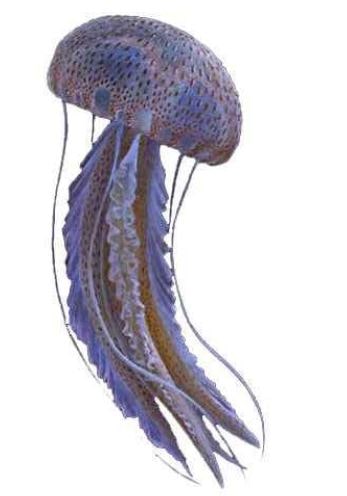2.2 Jellyfish bloom cases in the Mediterranean Sea
The presence of jellyfish blooms in the Mediterranean is known since the beginning of the study of marine life. Goy et al. (1988) made an extensive bibliographic search, looking for accounts of blooms of the mauve stinger (Pelagia noctiluca) (Fig. 12) in the literature dealing with Mediterranean Sea biota.

Figure 12. Pelagia noctiluca (art by A. Gennari).
The first account found by Goy et al. (1988) dates back to 1775 (Forskal, 1775) and in the same report the authors list 55 records of Pelagia noctiluca blooms in the period 1775–1987, identifying a possible periodicity of about 12 years in the occurrence of these episodes of apparently abnormal abundance of this species (Fig. 13).

Figure 13. Periodicity of Pelagia noctiluca blooms. Open circles: years without Pelagia. Closed circles: years with Pelagia. Solid line: probability of Pelagia blooms (after Goy et al., 1988).
This species is present in swarms also in other European waters. Russell (1970), for instance, reports an account by Cole (1952) who stated: “the sea looked as if converted into a solid mass of jellyfish”.
In spite of the interest of some authors to report on these events, however, chances are good that most of these blooms simply passed unnoticed. The reasons for this are manifold: ? Blooms can occur in restricted areas where the jellyfish are concentrated in large quantities, but where no researchers are active at that time.
? Blooms are observed but no accounts are published, simply because the observation is not considered as having sufficient interest for a scientific publication.
? Blooms are reported in papers only with a few lines, being considered as simple anecdotes, their record being very difficult to trace.
Interest in these phenomena started in the early 1980s, when a basin-wide massive occurrence of Pelagia noctiluca affected almost the whole Mediterranean basin, including the Adriatic Sea, where the blooms of Pelagia had been noticed starting from 1977 (Malej and Malej, 2004). The United Nations Environmental Programme (UNEP), through the Mediterranean Action Plan (MAP) launched a project that made money available to study these phenomena. Research activities culminated into two Workshops that took place in 1983 (UNEP, 1984) and in 1987 (UNEP, 1991) respectively. In those workshops, and in several papers published in scientific journals by the participants to the project, all available information on Pelagia noctiluca blooms in the Mediterranean were assembled, culminating in the review by Goy et al. (1988) reporting about the periodic occurrence of Pelagia blooms.
The massive blooms of Pelagia of the early 1980s, however, soon reached an end, and the situation went back to “normal”, or, better, went into other directions and jellyfish were soon forgotten. The people who studied these events changed their topics of research (due to lack of fund availability) even though jellyfish blooms appeared every once in a while, without sparking any interest from funding agencies.
In 2001, the Mediterranean Commission (CIESM) organized a workshop on Gelatinous plankton blooms (CIESM, 2001), linking the blooms of Pelagia of the early 1980s with the blooms of the alien ctenophore Mnemiopsis leidyi in the Black Sea that started in the same period and that continued in a massive way. The rationale of the CIESM workshop was to consider these blooms as part of a general trend, along with what had been already highlighted by Mills at a global level (1995; 2000).